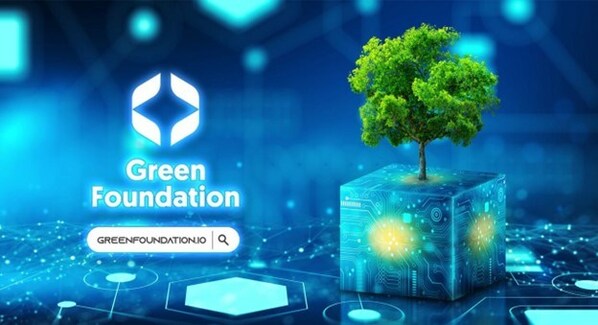How the Green Foundation is using blockchain technology to help fight deforestation and global warming
[gpt3]rewrite
SINGAPORE, 2 June 2023 /PRNewswire/ — The environmental challenges of deforestation and global warming have reached critical levels, causing irreparable damage to the planet’s ecosystems. The urgent need to prevent climate change has led to the creation of several technologies and strategies. One of the best solutions is Blockchain technology. Green Foundation uses Blockchain technology to help in the fight against deforestation and global warming.
In recent years, blockchain technology has emerged as a powerful tool that can contribute significantly to the fight against deforestation and the reduction of greenhouse gas emissions. By leveraging the transparency, immutability and traceability of blockchain, the Green Foundation can increase the transparency and accountability of its initiatives.
In this article, we will explore how blockchain technology, especially when used by organizations such as the Green Foundation, can help combat the environmental crisis. Through its implementation, blockchain technology has the potential to revolutionize the way we deal with deforestation and global warming, paving the way for a more sustainable future.

How the Green Foundation is using blockchain technology to help fight deforestation and global warming
#1: Improve transparency and accountability
One of the fundamental advantages of blockchain technology is its ability to provide transparency and accountability throughout complex supply chains. In the context of deforestation, blockchain can track and record the origin of timber and other forest products, ensuring their legality and sustainability.
By leveraging blockchain, a decentralized and immutable ledger, it becomes possible to track and record every step of the supply chain process. This includes the origin of raw materials, the movement of products and the various transactions involved. Such transparent and auditable registration helps to track the carbon footprint of products and materials, and guarantees their legality and sustainability.
#2: Improving the creation process and management of carbon credits
Carbon credits are transferable licenses that enable organizations and businesses to release a certain amount of greenhouse gases. By obtaining carbon credits, companies can reduce their carbon footprint and participate actively in reducing climate change.
Blockchain provides a transparent and secure platform for tracking carbon credits, ensuring the accuracy and integrity of transactions. The decentralized ledger records all carbon credit transactions in real time, preventing fraud and providing a tamper-proof system.
By eliminating the need for intermediaries, Blockchain simplifies the process and reduces administrative burdens. Smart contracts automate compliance and enable seamless transactions, improving overall efficiency. Moreover, the transparency and traceability of the blockchain promotes trust and accountability in the carbon credit market. Stakeholders can easily track the life cycle of carbon credits, promote responsible practices and attract more participants.
#3: Promote renewable energy
Through blockchain, individuals and organizations can exchange renewable energy directly without the need for centralized tools. This facilitates a peer-to-peer energy market where excess renewable energy generated from sources such as solar and wind power can be sold to others in a transparent and efficient manner.
By leveraging blockchain, barriers to entry for renewable energy are reduced, making it more accessible and affordable for consumers. People with solar panels or wind turbines can easily sell their excess energy to those who need it, promoting a decentralized and sustainable energy ecosystem. Blockchain also ensures the integrity and authenticity of renewable energy transactions by providing a secure and tamper-proof platform for tracking the production and consumption of renewable energy.
#4. Facilitation of carbon offset programs
Blockchain has the potential to revolutionize the carbon offset market, making it more efficient and accessible to businesses and individuals. Through tokenization on the blockchain, carbon credits can be digitized and easily traded, reducing the complexity and costs associated with traditional carbon offset programs. Blockchain’s transparency and immutability provide confidence in the legitimacy of carbon credits, ensuring that emissions reductions are accurately accounted for and credited to the appropriate entities. This streamlined process could encourage greater participation in carbon offset programs and contribute to global efforts to reduce climate change.
#5: Encourage the planting of trees and afforestation.
With the integration of Blockchain technology, the scope and impact of tree planting and reforestation projects can be significantly expanded.
Blockchain technology enables increased transparency and accountability in tree planting and afforestation. By recording and verifying each step of the process on an immutable ledger, stakeholders can trust that their contributions are being used efficiently and ethically.
Carbon credits serve as a means for companies to compensate for their environmentally harmful activities by supporting financial support projects that contribute to environmental conservation. This mechanism enables companies to balance their carbon footprint by investing in initiatives that reduce the negative impact of their own less climate-friendly practices.
Many companies, including the Green Foundation, Toucan and KlimaDAO, are trying to improve the transparency and accountability of carbon credits.
The Green Foundation is at the forefront of incorporating blockchain technology into reforestation projects, aiming to increase transparency and accountability in their initiatives. The Green Foundation provides its users with detailed information on how their staked tokens are being used in tree planting and reforestation projects. Every tree and piece of land involved in these initiatives is recorded and traceable, ensuring that users are well informed about the impact of their contribution. In addition, the Green Foundation offers a real-time tracking system for tree planting, monitoring growth and verifying the project’s results.
The Green Foundation offers a powerful solution to combat deforestation and global warming. By increasing transparency in supply chains, simplifying the management of carbon credits, promoting the use of renewable energy, revolutionizing the carbon offset market and supporting tree planting initiatives, blockchain has the potential to drive significant positive change. Embracing blockchain can pave the way for a greener and more sustainable future as we work to mitigate the environmental challenges we face.
More about us:
Website:
Twitter: https://twitter.com/green_tripx
Telegram channel:
[gpt3]


